By now, the name John Wick has become synonymous with total, all-encompassing badassery. For the past decade, fans of the character have fantasized about how amazing life could be if we possessed even a fraction of Wick's strength, agility, cunning, and sheer violence of action.
Well now, thanks to Jacked Factory, you can find out – with Wick Mode Pre-Workout.
The John Wick Pre-Workout – Become Unstoppable

In collaboration with John Wick... the Jacked Factory Wick Mode pre-workout contains 250 milligrams of Cognizin citicoline paired with ~375mg caffeine from two sources for extreme focus - and is matched by 8 grams of citrulline for pumps!
But even with all those insanely powerful mental and physical abilities, there's one thing about John Wick that is simply unsurpassed. His sheer grit.
It's hard to think of a protagonist that's harder to stop than John Wick. No matter how daunting the odds, he doesn't shrink from any fight, and in the end, thanks to his steadfast refusal to ever give up, he almost always prevails.
That's exactly the mentality that we should bring into our workouts – never give up; never quit. The ingredients in Jacked Factory's John Wick Pre-Workout have been carefully chosen to help you persevere through your most challenging workouts.
And God help anyone who messes with your dog after using it.
Featuring 250mg Cognizin® Citicoline
The best way to get focus a la John Wick in a battle scene? With none other than Cognizin® Citicoline, the industry's go-to ingredient for a cognitive edge.
Let's get into how Wick Mode works, but first, check PricePlow for product availability and sign up for our Kyowa Hakko news and deals, as they're the sponsor of this article:
Jacked Factory John Wick Mode Pre-Workout – Deals and Price Drop Alerts
Get Price Alerts
No spam, no scams.
Disclosure: PricePlow relies on pricing from stores with which we have a business relationship. We work hard to keep pricing current, but you may find a better offer.
Posts are sponsored in part by the retailers and/or brands listed on this page.
This area is reserved for Team PricePlow's upcoming videos.
Subscribe to our channel and sign up for notifications so you catch it when it goes live!
Jacked Factory Wick Mode Ingredients
In a single 2-scoop (19.6 gram) serving of Wick Mode Pre-Workout from Jacked Factory, you get the following:
-
L-Citrulline – 8,000 mg
Citrulline is an amino acid that increases your body's synthesis of nitric oxide (NO),[1] and Wick Mode starts it off right with some serious... blood flow.
It's a non-essential amino acid — so, your body does produce some citrulline on its own, but not necessarily enough to optimize citrulline-related NO synthesis. Ultimately, if you're working out hard, then you may wish to consider supplemental citrulline to take up the slack.
The citrulline-to-arginine conversion pathway is Citrulline → Arginine → NO.
At first glance, it might seem like it would make more sense to take arginine instead of citrulline if the goal is to boost NO production. After all, arginine is a more direct precursor to NO. But as it turns out, citrulline's oral bioavailability is so much better than arginine that oral citrulline supplements end up being better at increasing the amount of arginine in the blood.[2,3]
In case you need a refresher on why we want more circulating NO when we go into a workout, recall that NO is the molecule that triggers the pump that so many bodybuilders chase. It does this by triggering vasodilation, a mechanism that causes your arteries to expand in diameter. The wider the arteries, the more easily blood flows, leading to drops in blood pressure and heart rate.[4-6]
The Arginine Citrulline Cycle with a breakout showing the arginine-to-nitric oxide reaction. Image courtesy Wikimedia with added biochemistry sources.[7,8]
Cardiovascular microvessels also dilate in response to NO,[9] which can significantly improve perfusion, especially in peripheral tissues. Improved perfusion can lead to better performance and recovery, as oxygen and nutrients get delivered to cells, and metabolic wastes removed from cells, more efficiently.
Through this effect, clinical research trials have shown that citrulline can support athletes in numerous ways.[10-15]
Citrulline supplementation can also increase the body's production of ornithine, an amino acid that removes the toxic metabolic byproduct ammonia from tissues.[16,17] Since ammonia buildup can create mental and physical fatigue, helping your body get rid of ammonia faster can indirectly boost endurance.
Ornithine also helps you sleep better and reduces stress because it can decrease the body's ratio of cortisol to DHEA.[17]
As mentioned above, this is the no-joke dose. Yes, you can get statistically significant results from less, but citrulline's prowess really begins to show at the 6 and over dose range, for those who are really chasing a pump.
-
Beta-Alanine – 4,000 mg
Beta-alanine is an ergogenic aid, defined as any substance or technique that can increase the body's capacity for physical work.
Along with the amino acid histidine, beta-alanine is one of two precursors to a dipeptide molecule called carnosine, whose role is to remove lactic acid (aka lactate) from your muscles.[18] Basically, the less carnosine your muscles have, the less efficiently they'll be able to get rid of lactic acid – and the faster lactic acid builds up, the faster you're likely to feel physically tired during exercise.
On the other hand, by supplementing beta-alanine, we can help the body get rid of lactic acid faster, thus delaying the onset of fatigue and boosting athletic endurance. Beta-alanine supplementation is a great strategy for boosting carnosine for two reasons: first, since histidine is abundant in common foods, beta-alanine is almost always the limiting factor in your body's synthesis of carnosine;[18] second, the oral bioavailability of carnosine itself is not great – beta-alanine's is vastly better, making it a more effective choice for supplementation.[19]
Tons of peer-reviewed studies have backed up beta-alanine's ability to increase athletic endurance.[18,20-22] Three meta-analyses of the beta-alanine literature found that a 3,200 mg daily dose, which is actually less than what we have in Wick Mode, can significantly increase endurance and decrease fatigue.[20-22] It's most effective at doing this in exercises that last anywhere from 30 seconds to 10 minutes.[20,21]
4 grams for faster carnosine saturation
We're fans of the dose -- the goal is to get to carnosine saturation, and 4 grams should do it faster than 3.2... you'll almost definitely be feeling it at this level.
-
L-Tyrosine – 2,000 mg
Tyrosine is a precursor to the catecholamines, a category of neurotransmitters and hormones that includes dopamine, norepinephrine (noradrenaline), and epinephrine (adrenaline). The catecholamines regulate a number of key physiological processes, including heart rate, blood pressure, metabolism, and stress response.
The catecholamines get released into the bloodstream by the adrenal glands in response to stress or excitement, and also serve as neurotransmitters in the brain, where they affect neural activity, mood, and behavior. They all play crucial roles in supporting focus, motivation, and cognition.[23-25] Dopamine, in particular, is hugely important for all of the above.
Adrenaline and noradrenaline, on the other hand, can help support fat loss by decreasing appetite and increasing your body's rate of lipolysis (fat burning).[26,27]
Supports the thyroid
While optimized catecholamine signaling is of obvious importance, what's arguably even more important for body composition and athletic performance is optimal thyroid function. And, fortunately for us, tyrosine can help here, too. It's also a precursor to triiodothyronine (T3) and thyroxine (T4), the two hormones produced in the thyroid.[28,29] T4 is the most abundant thyroid hormone produced by the thyroid gland. When needed, T4 is converted into T3, the biologically active form in many tissues, including the liver and kidneys. Both T4 and T3 are essential for proper thyroid function and metabolic health.
The reason this is such a big deal is that the thyroid is your body's metabolic master gland – it regulates energy production in all your body's cells. Unfortunately, thyroid function can drop significantly when the body is subjected to diet and exercise[28-30] – two behaviors that, if you're in the market for a pre-workout, you probably practice at least periodically.
Restores cognitive performance during sleep deprivation
Tyrosine is also good for reducing the negative effects of sleep deprivation, particularly the impact that lack of sleep has on cognition. According to studies conducted by the U.S. military, tyrosine is actually better at this than caffeine, which is saying something![31,32]
-
Caffeine Anhydrous – 300 mg (of 375 mg total)
Caffeine is a methylxanthine stimulant. Since the blood-brain barrier is permeable to caffeine,[33] the stimulant has a profound effect on the workings of the brain.– as most of us know from personal experience. – Caffeine's legendary ability to elevate mood, sharpen focus, increase energy levels, and even enhance athletic performance[34] has earned it the status of staple supplement for people the world over.
Are you a slow, medium, or fast caffeine metabolizer? In this study, ~46% of all participants were fast caffeine metabolizers (A/A),[35] and can crush a good hit of Wick Mode!
Caffeine's anti-fatigue effects can be explained in terms of its ability to antagonize adenosine, a chemical that's generated as a byproduct of adenosine triphosphate (ATP) breakdown, and accumulates while we're awake, causing fatigue.[36,37] In this sense, caffeine figuratively gives us more energy by preventing us from feeling tired.
However, caffeine does also give us more energy in the most literal possible way – it downregulates an enzyme called phosphodiesterase, whose function it is to break down a messenger molecule called cyclic adenosine monophosphate (cAMP).[34,36-39] Less phosphodiesterase activity means more cAMP, and since cAMP tells your cells to produce energy, caffeine administration ultimately increases cellular energy production.[34,36-39]
Caffeine is also a potent fat burning supplement that has been shown to increase the body's rate of lipolysis by up to 50%.[40,41] A 2020 meta-analysis of 19 studies found that significant boosts in fat oxidation can be seen with doses as small as 3 mg caffeine per kilogram of bodyweight.[42]
When it comes to athletic performance, caffeine has been shown to increase strength, power, speed, and endurance.[34,36,38,40,41]
On the brain side of things, caffeine can increase attention, alertness, reaction time, and working memory.[43-45]
The total caffeine in Wick Mode is 375 mg (thanks also to some dicaffeine malate), which is definitely a lot to take in one sitting! If you aren't sure whether you can tolerate this much caffeine, please ask your doctor!
-
Cognizin Citicoline (CDP-Choline) – 250 mg
Sold by Kyowa Hakko, Cognizin® citicoline is PricePlow's preferred form of choline. This is thanks to the fact that citicoline, unlike ordinary choline, is one of the building blocks for phosphatidylcholine (PC), a phospholipid that's crucial for brain health and cognitive performance.[46] As a matter of fact, citicoline is often the rate-limiting factor in your body's ability to synthesize PC.[47]
Cognizin® Citicoline is dubbed the The Brain Choline not just because it provides choline, but because it also supplies cytidine, which is also needed for the synthesis of phosphatidylcholine
Citicoline has evidence backing its ability to upregulate PC synthesis – an MRS study in humans that directly measured a rise in PC metabolites after citicoline administration.[48]
Research shows that a 250 mg daily dose of Cognizin – the same dose we have in Wick Mode pre-workout – can do the following:
- Support focus and attention[49-52]
- Supports focus to reduce errors while on task[49,50]
- Supports brain and cognitive health[49,50,52-54]
- Supports acetylcholine production[51,55,56]
Long story short, if you're looking for John Wick's laser-like focus with a compliant dietary supplement ingredient, then this is the first ingredient you include after caffeine.
It's worth noting that some research on 500 milligrams a day even shows it supports memory in older adults.[57] Of course, we don't have that much Cognizin in Wick Mode, but we're happy to see that 250 milligrams still has plenty of power, as shown by the vast research above.
Dopamine upregulation
The thing we love most about citicoline is its apparent ability to support dopamine levels, by increasing both dopamine synthesis[49,58,59] and dopamine receptor density.[60] Furthermore, citicoline seems to have a neuroprotective effect on dopaminergic neurons.[61]
Cytidine and uridine
Both cytidine and choline are needed for the synthesis of phosphatidylcholine, a phospholipid with particular benefits for brain health.[62,63]
Chemically, Cognizin citicoline provides cytidine, and without this critical component, the body may not be able to convert much choline into the phospholipids we need for it to maintain cellular membranes. Citicoline is simply quicker to get to phosphatidylcholine, due to less steps required. This is shown in the image inset.
The latest study performed on Cognizin® Citicoline was published in 2021, showing improved memory in healthy older adults.[57]
Research also shows that citicoline can effectively raise cytidine and uridine levels.[55,64]
If you want to read our comprehensive article on this ingredient, check out our previous post, Cognizin Citicoline: The Brain Choline.
-
Infinergy (DiCaffeine Malate) – 100 mg (yielding 75 of 375 mg total)
Dicaffeine malate consists of caffeine and malic acid (malate) chemically compounded. Compared to caffeine anhydrous, dicaffeine malate is absorbed into the bloodstream more gradually thanks to the buffering effect that the bond between the two molecules during digestion.
This delayed absorption creates a more gradual energy curve. If you plot the
serum concentration of caffeine over time, dicaffeine malate peaks lower, but lasts longer, than the anhydrous stuff. This is beneficial in a number of ways – lower peak concentration means you're less likely to deal with the familiar adverse effects of caffeine (e.g. jitters, anxiety), and also, the withdrawal process will be a lot more forgiving.
Combining anhydrous caffeine with a buffered form like dicaffeine malate is an increasingly popular strategy for giving consumers the best of both worlds: a quick burst of energy from theanhydrous, while still retaining the more gradual taper thanks to dicaffeine malate.
Plus, obviously, we're getting a little more caffeine overall. Caffeine malate is roughly 75% caffeine by weight, so this adds an additional 75 mg of caffeine to Wick Mode Pre-Workout. This brings the total caffeine in Wick Mode up to 375 mg, which is definitely a lot to take in one sitting! If you aren't sure whether you can tolerate this much caffeine, please ask your doctor!
-
L-Theanine – 100 mg
The amino acid theanine occurs naturally in Camellia sinensis leaves – that is, true tea (as opposed to herbal infusions). In the brain, theanine acts like a neurotransmitter,[65] and has tranquilizing, anxiolytic, and inhibitory effects on brain cells.[66-68]
What's great about theanine is that it accomplishes all of this without having sedative effects on the CNS. This makes it a great complement for stimulants like caffeine – pairing theanine and caffeine gives you the faster metabolism and decreased fatigue, but without as much of the anxiety or jitteriness.
Theanine came to prominence in the early 2010s, when biohackers discovered the theanine-caffeine stack to be an inexpensive, efficacious, and safe nootropic stack. Studies consistently show that when it comes to improving cognition, the combination of theanine and caffeine outperforms either ingredient alone.[67]
-
Theobromine – 100 mg
Theobromine is a methylxanthine alkaloid that has stimulant, vasodilating, and bronchodilating properties.[69]
Since caffeine is also a methylxanthine alkaloid, you'd probably expect theobromine to have some similarities – and you'd be right. Just like caffeine, theobromine boosts cAMP via phosphodiesterase inhibition,[70] which ramps up cellular metabolism.[71,72]
Surprisingly, while caffeine is a vasodilator, theobromine is a more powerful vasodilator that— even though it's a stimulant — relaxes smooth muscle to a greater extent for net reductions in blood pressure and heart rate. –![73] In fact, theobromine is often co-administered with caffeine specifically to cancel out caffeine's hypertensive effect.[74]
Theobromine also has a significantly longer half-life than caffeine, so it tapers more gradually and causes much milder withdrawal effects.[75]
-
AstraGin (Astragalus membranaceus (root), & Panax notoginseng Extract (root)) — 50 mg
AstraGin is a patented bioavailability-enhancing ingredient, designed to facilitate your body's absorption of nutrients from food and supplements.[76-80] It works by increasing your intestinal cells' ability to produce adenosine triphosphate (ATP), thus increasing the amount of cellular energy they have at their disposal. Thanks to the extra energy, those intestinal cells can work more efficiently, thus increasing their ability to transport nutrients into your bloodstream.
By this mechanism, AstraGin can increase the bioavailability of pretty much anything you ingest alongside it. For a premium pre-workout formula like Wick Mode, the inclusion of AstraGin is a no-brainer because it maximizes the value you get for every dollar you spend on the product.
Regular use of AstraGin can even improve intestinal health in the long run.[81]
Flavors Available
Unlock your Inner John Wick
John Wick Pre-Workout from Jacked Factory has everything you need on the ergogenic aid side of things – large doses of citrulline, beta-alanine, and caffeine will take care of you here. Plus, we have a nice lil' 100 mg serving of theobromine to counteract caffeine's tendency to increase blood pressure and heart rate.
On the cognitive side of things, caffeine, tyrosine, and Cognizin citicoline are here to seriously boost dopamine signaling. Because of dopamine's profound effect on focus and motivation, we think this is what sets Wick Mode apart from most other pre-workouts on the market.
In particular, we love seeing the Cognizin paired with a 2 gram dose of tyrosine. If you're looking to get in the zone like John Wick, that's right where we'd start (next to 300 milligrams of caffeine, of course).
Now how's that for a licensed collab?!
Jacked Factory John Wick Mode Pre-Workout – Deals and Price Drop Alerts
Get Price Alerts
No spam, no scams.
Disclosure: PricePlow relies on pricing from stores with which we have a business relationship. We work hard to keep pricing current, but you may find a better offer.
Posts are sponsored in part by the retailers and/or brands listed on this page.
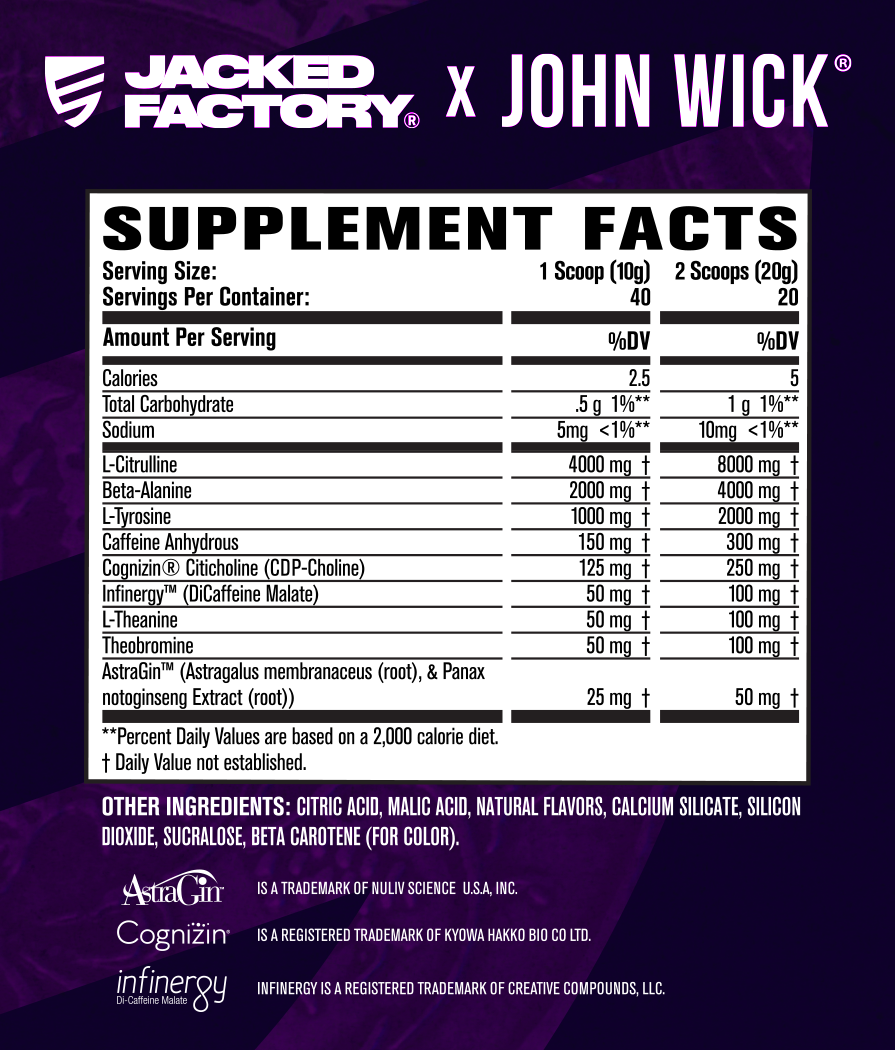
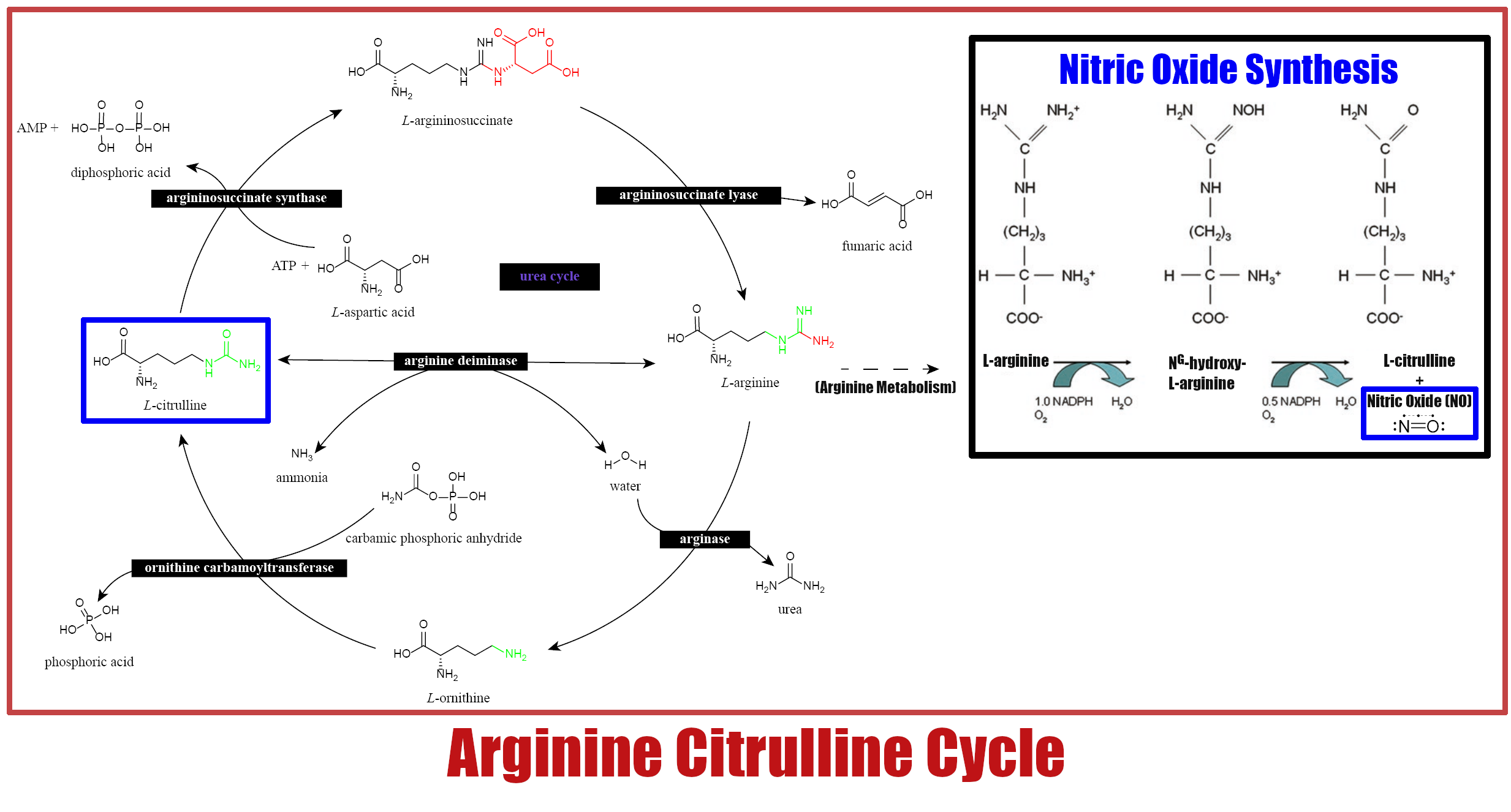
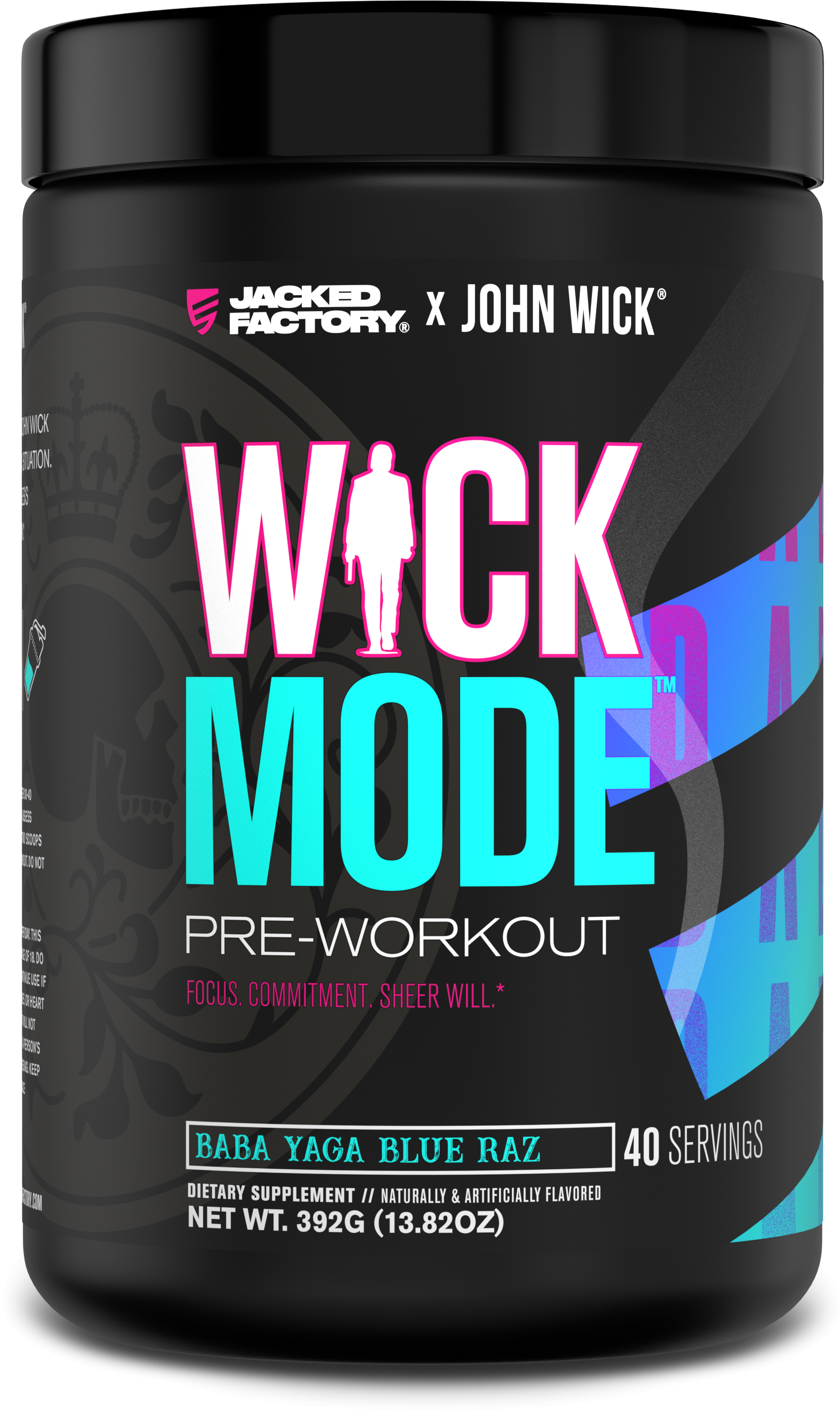
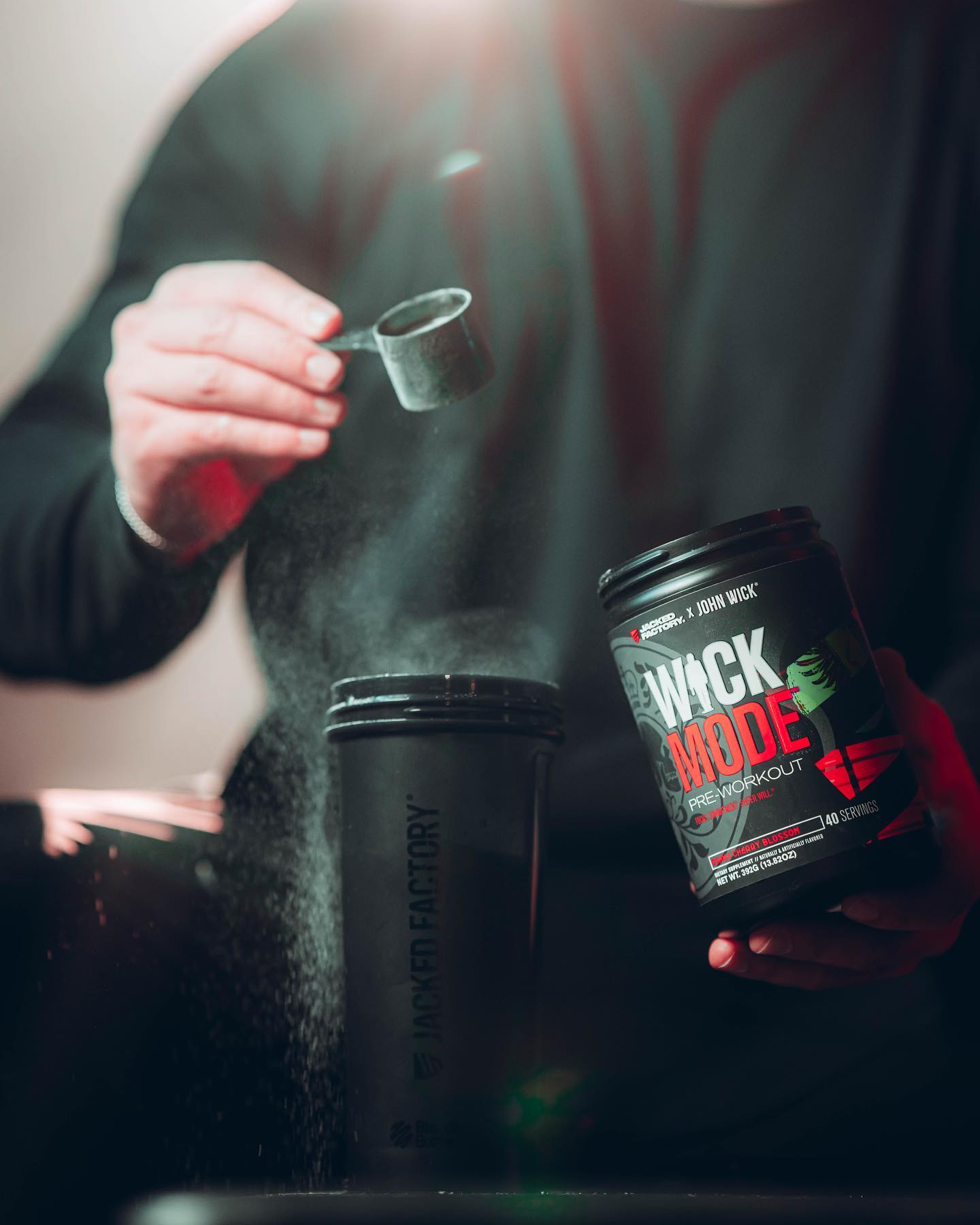
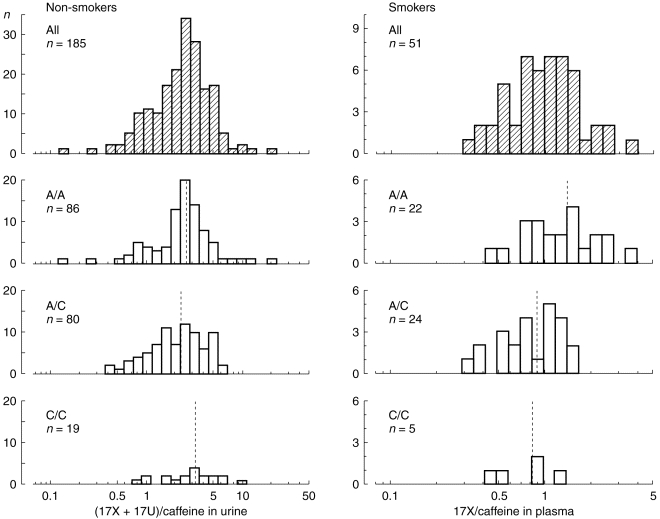
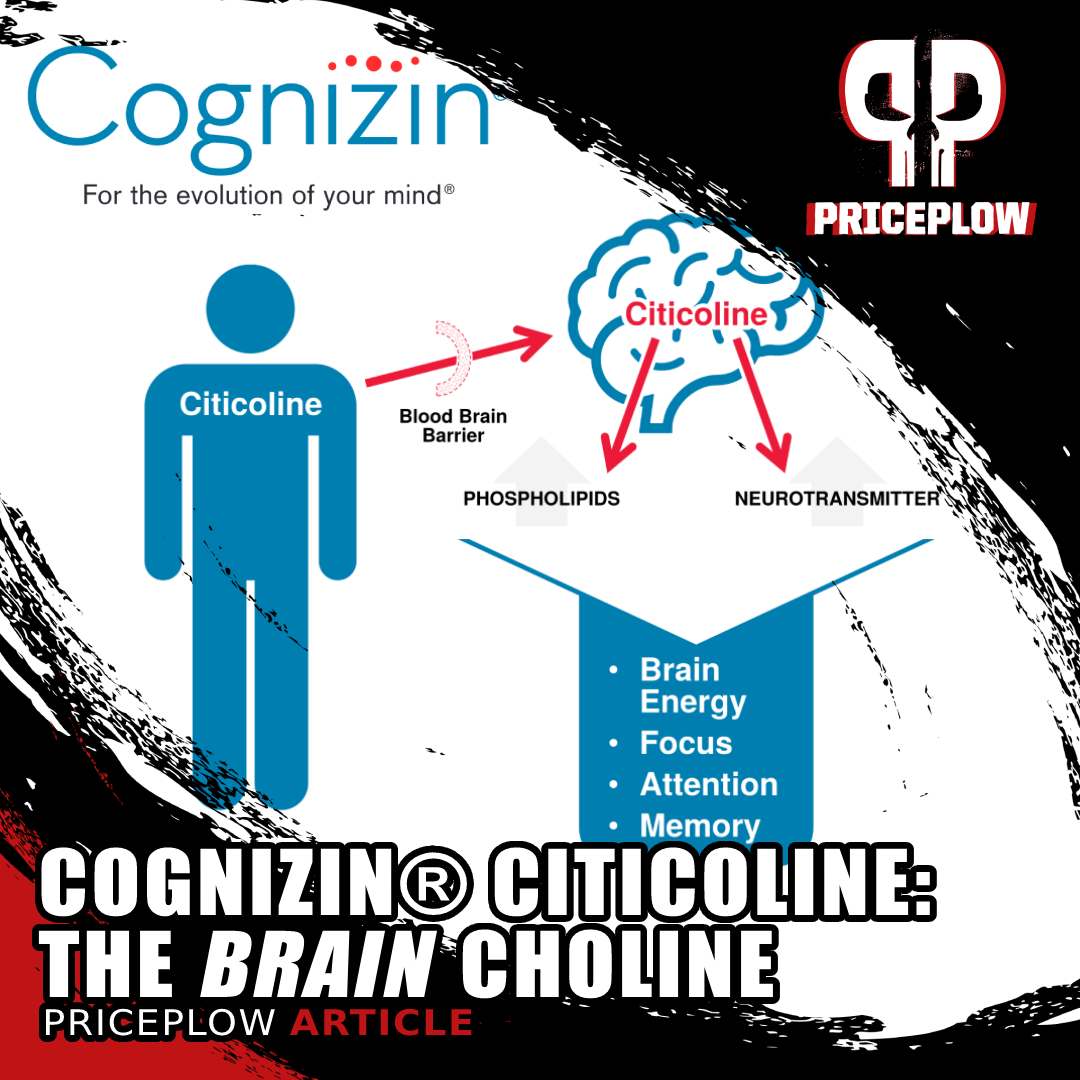
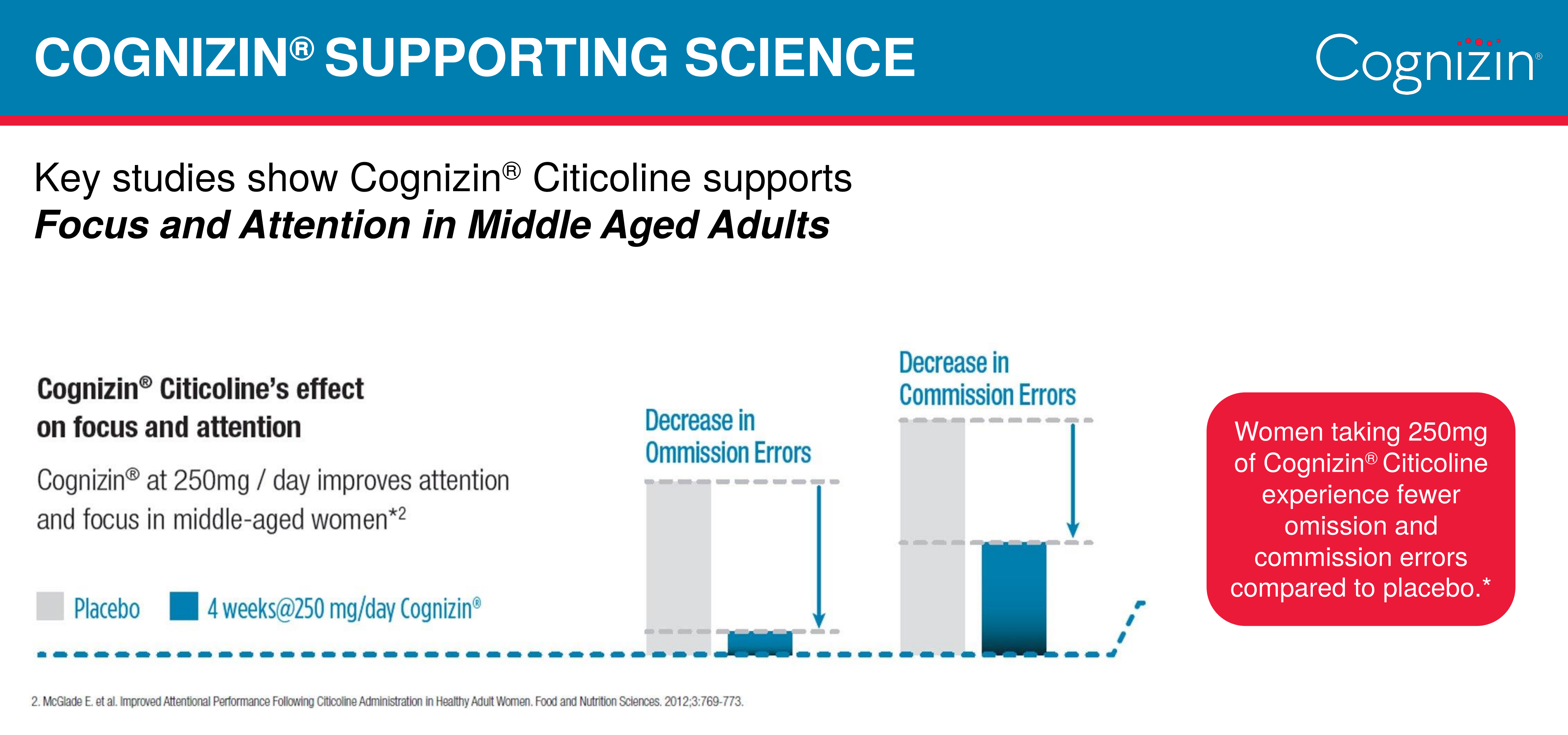
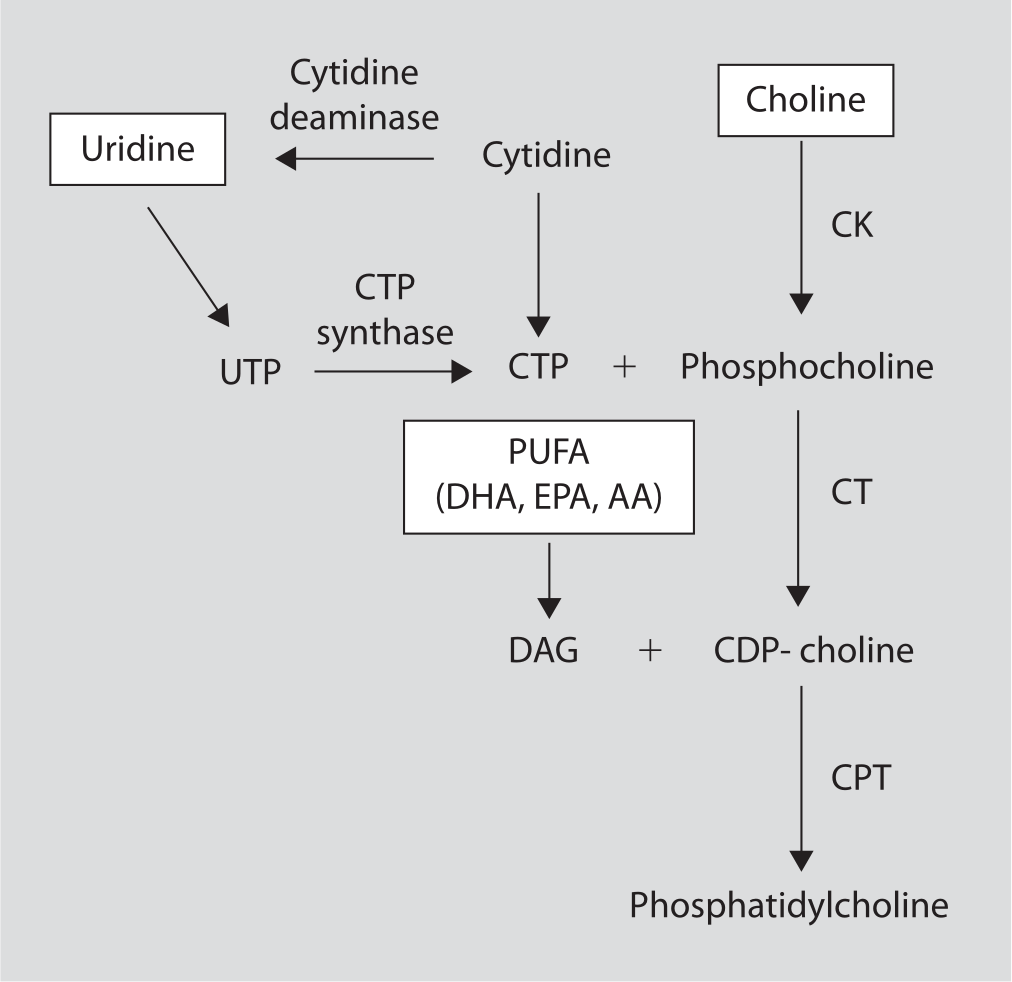

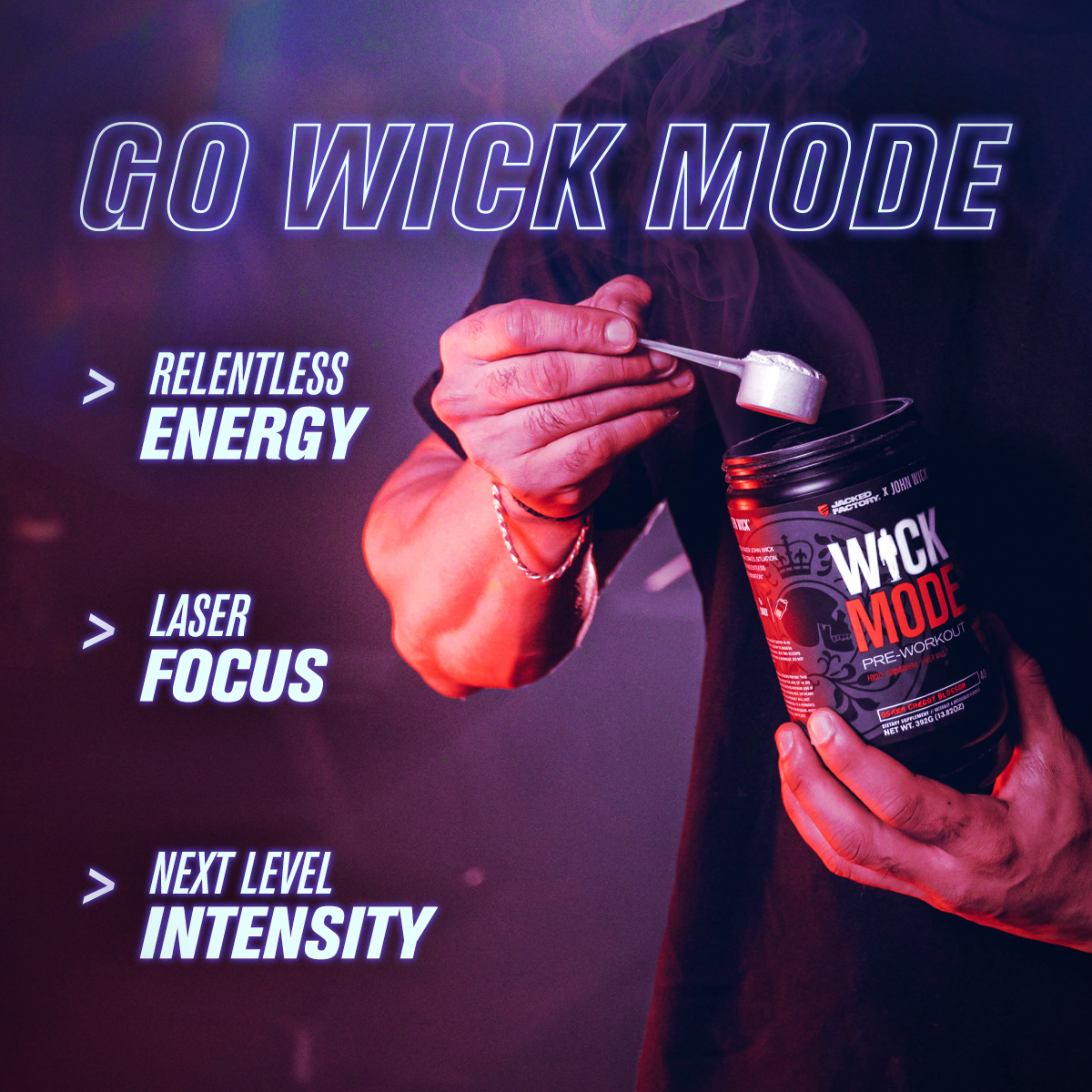
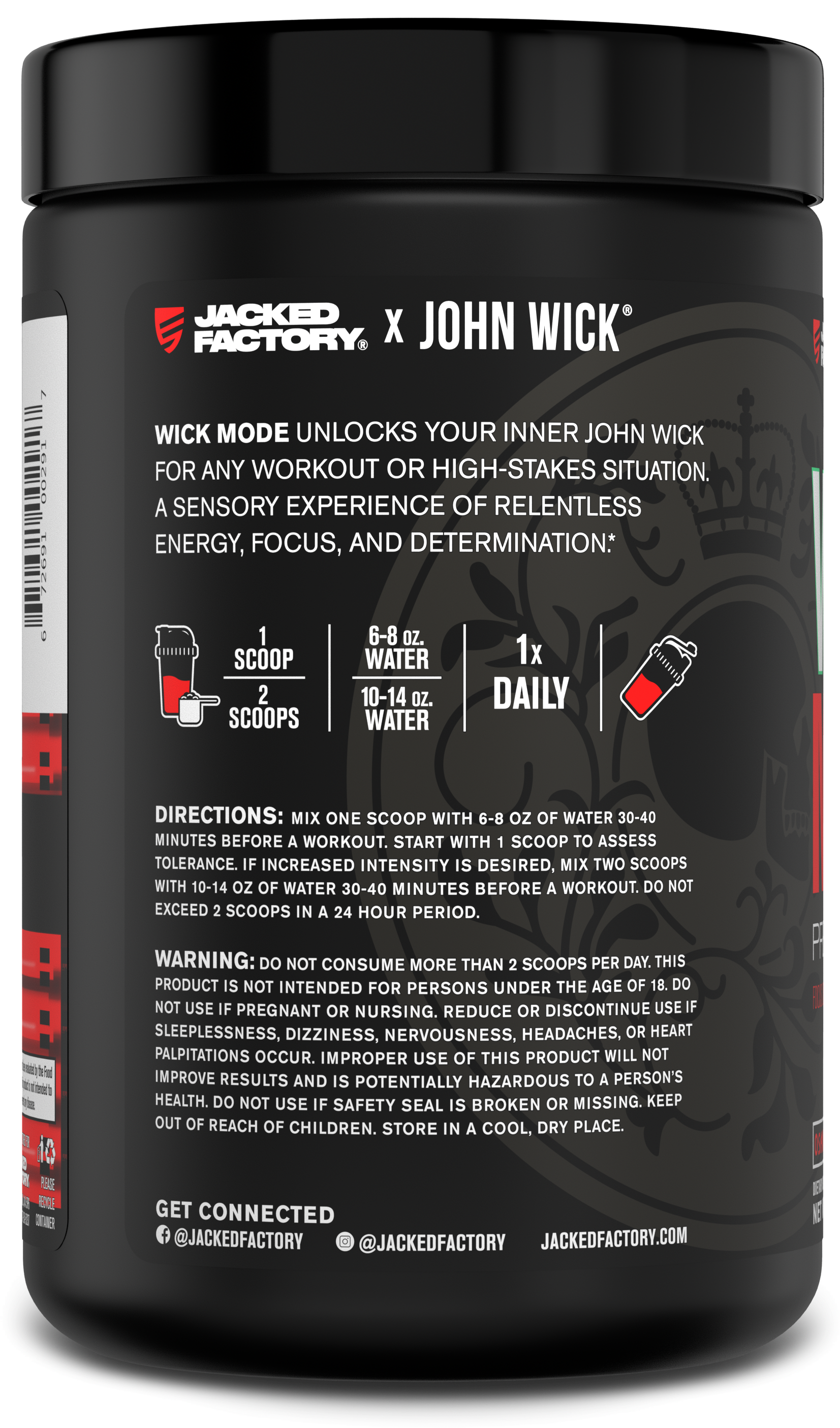
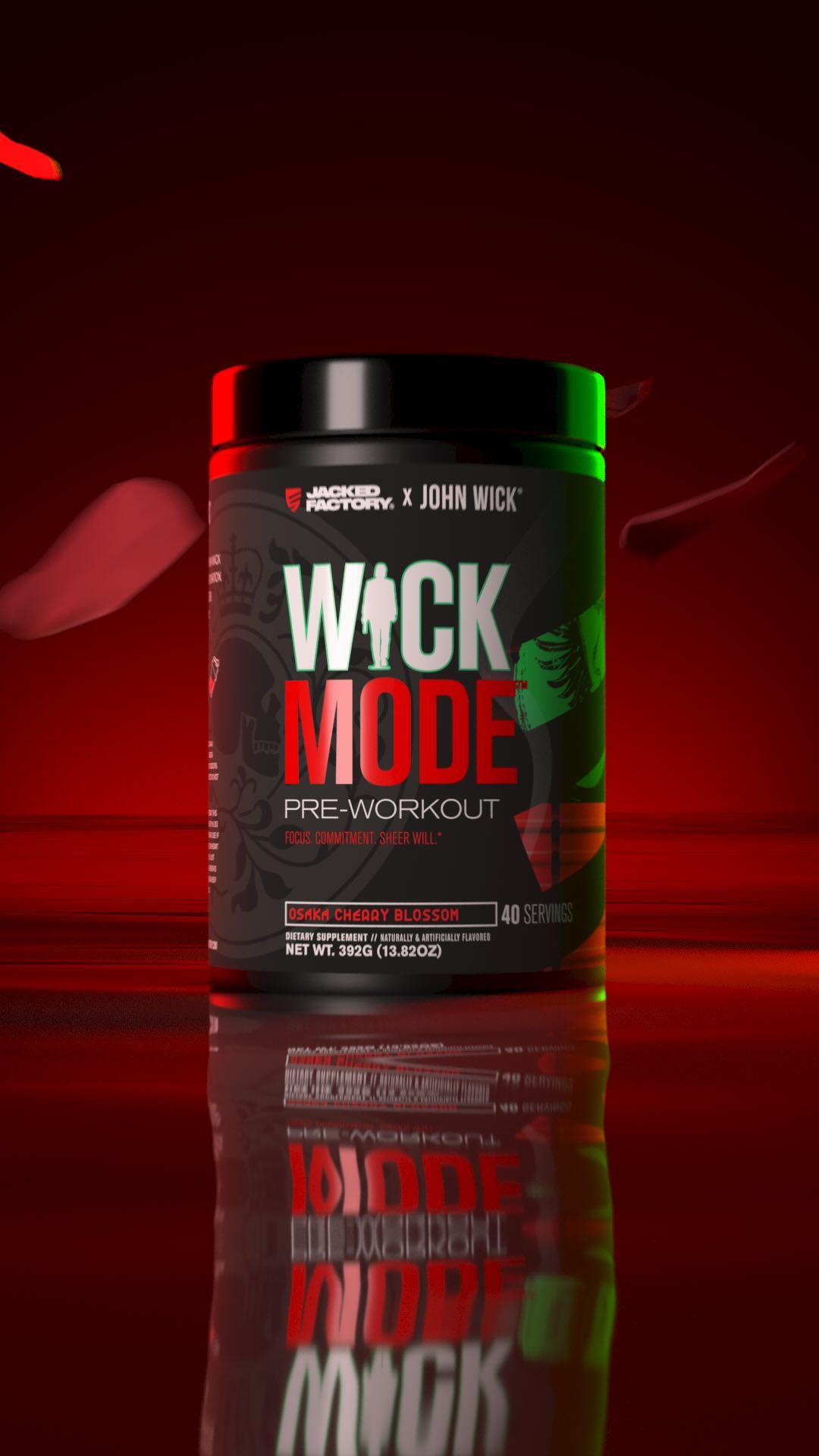


Comments and Discussion (Powered by the PricePlow Forum)